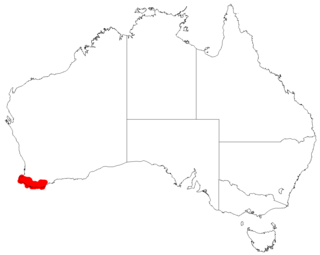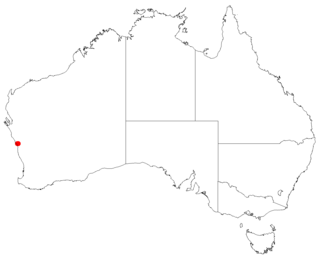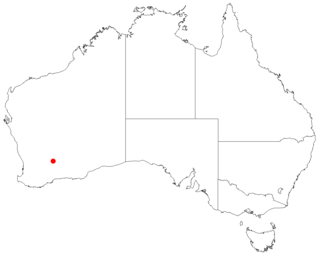
Andersonia is a genus of mostly small, evergreen shrubs in the family Ericaceae and is endemic to the Southwest Botanical Province in Western Australia.

Leucopogon inflexus is a species of flowering plant in the heath family Ericaceae and is endemic to the south-west of Western Australia. It is an erect, open shrub with more or less glabrous young branchlets, spirally arranged, erect, egg-shaped to more or less round leaves, and white, bell-shaped, densely bearded flowers.

Leucopogon interstans is a species of flowering plant in the heath family Ericaceae and is endemic to the south-west of Western Australia. It is an erect shrub with brownish hairs on its young branchlets, erect, narrowly elliptic or narrowly egg-shaped leaves and white or pinkish flowers in groups in upper leaf axils or on the ends of branches.
Conostephium papillosum is a species of flowering plant in the family Ericaceae and is endemic to the south of Western Australia. It is a compact shrub with erect, narrowly elliptic or narrowly egg-shaped leaves with the narrower end toward the base, and pendulous, spindle-shaped, cream to straw-coloured and dark purple flowers.

Leucopogon maritimus is a species of flowering plant in the heath family Ericaceae and is endemic to the west coast of Western Australia. It is a low, spreading shrub with hairy young branchlets, erect, narrowly elliptic leaves and erect white, tube-shaped flowers in upper leaf axils or on the ends of branches.
Conostephium prolatum is a species of flowering plant in the family Ericaceae and is endemic to the south of Western Australia. It is an erect shrub usually with narrowly egg-shaped or narrowly triangular leaves with the narrower end toward the base, and more or less pendulous, spindle-shaped, cream to straw-coloured and dark purple flowers.

Leucopogon navicularis is a species of flowering plant in the heath family Ericaceae and is endemic to the southwest of Western Australia. It is an erect, compact shrub with hairy young branchlets, narrowly elliptic to narrowly egg-shaped leaves and erect, compact clusters of 4 to 12 white, bell-shaped flowers in upper leaf axils or on the ends of branches.

Leucopogon prolatus is a species of flowering plant in the heath family Ericaceae and is endemic to the south-west of Western Australia. It is an erect, open shrub with a single stem at ground level, egg-shaped to elliptic leaves and erect clusters of 3 to 14 white flowers on the ends of branches and short side-branches.

Leucopogon validus is a species of flowering plant in the heath family Ericaceae and is endemic to a restricted part of the south-west of Western Australia. It is a robust shrub with glabrous branchlets, narrowly elliptic leaves and white, bell-shaped flowers arranged in six to twelve upper leaf axils and on the ends of branches.

Styphelia capillaris, commonly known as Horts' styphelia, is a species of flowering plant in the heath family Ericaceae and is endemic to a small area of south-western Western Australia. It is a dense, spreading shrub with narrowly egg-shaped to narrowly elliptic leaves and white flowers arranged singly or in pairs in leaf axils.
Brachyloma pirara is a species of flowering plant in the family Ericaceae and is endemic a restricted area in the west of Western Australia. It is an erect, compact shrub with sharply-pointed, linear to narrowly egg-shaped or narrowly elliptic leaves, and red, tube-shaped flowers.
Brachyloma stenolobum is a species of flowering plant in the family Ericaceae and is endemic to a restricted area in the west of Western Australia. It is an erect, compact shrub with narrowly elliptic or elliptic leaves, and white, tube-shaped flowers.
Styphelia quartzitica is a species of flowering plant in the heath family Ericaceae and is endemic to a small area in the south of Western Australia. It is an erect shrub with hairy young branchlets, sharply-pointed, linear or very narrowly egg-shaped leaves, and cream-coloured, tube-shaped flowers.

Styphelia williamsiorum is a species of flowering plant in the heath family Ericaceae and is endemic to a small area in the south-west of Western Australia. It is a low, compact shrub with decussate, narrowly egg-shaped leaves, and deep purple, tube-shaped flowers with hairy lobes.
Andersonia annelsii is a species of flowering plant in the family Ericaceae and is endemic to a restricted part of the southwest of Western Australia. It is a low shrub with egg-shaped to round leaves and white, tube-shaped flowers.
Andersonia ferricola is a species of flowering plant in the family Ericaceae and is endemic to a restricted part of the southwest of Western Australia. It is a straggling shrub with twisted, narrowly egg-shaped leaves and pale lilac, tube-shaped flowers.
Andersonia geniculata is a species of flowering plant in the family Ericaceae and is endemic to the southwest of Western Australia. It is a low, spreading shrub with twisted, linear or very narrowly egg-shaped leaves and white, tube-shaped flowers.

Andersonia hammersleyana is a species of flowering plant in the family Ericaceae and is endemic to the southwest of Western Australia. It is an erect or low-lying, straggling shrub with twisted, linear to narrowly egg-shaped leaves and bright blue, tube-shaped flowers.

Andersonia lehmanniana is a species of flowering plant in the family Ericaceae and is endemic to the south-west of Western Australia. It is a shrub with pointed lance-shaped leaves and white, cream-coloured or pink and blue or purple flowers.
Andersonia pinaster is a species of flowering plant in the family Ericaceae and is endemic to the south of Western Australia. It is a slender, erect, pine-like shrub with twisted, narrowly egg-shaped to almost linear leaves and bright blue, tube-shaped flowers.











